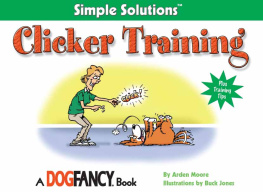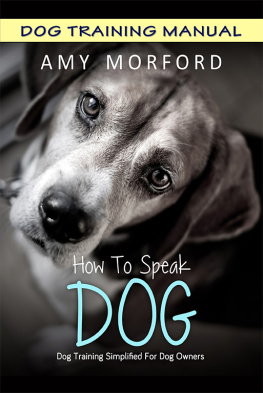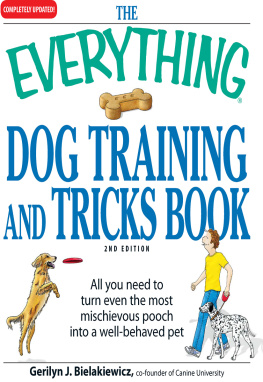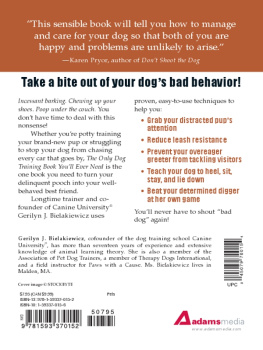Karla Austin, Business Operations Manager
Nick Clemente, Special Consultant
Jarelle S. Stein, Editor
Jennifer Perumean, Assistant Editor
Jill Dupont, Production
Michael Vincent Capozzi, Book Designer
Copyright 2005 by I-5 Press
Illustrations copyright 2005 by Buck Jones
The dogs in this book are referred to as he and she in alternating chapters.
All rights reserved. No part of this book may be reproduced, stored in a retrieval system, or transmitted in any form by any means, electronic, mechanical, photocopying, recording, or otherwise, without the prior written permission of I-5 Press, except for the inclusion of brief quotations in an acknowledged review.
Library of Congress Cataloging-in-Publication Data
Moore, Arden.
Clicker training / by Arden Moore ; illustrations by Buck Jones.
p. cm. -- (Simple solutions)
ISBN 1-931993-58-0
eISBN: 9781620080665
1. Dogs--Training. 2. Clicker training (Animal training) I. Title. II. Series: Simple solutions (Irvine, Calif.)
SF431.M8145 2005
636.7'0887--dc22
2004024832
I-5 Press
A Division of I-5 Publishing, LLC
3 Burroughs
Irvine, California 92618
Printed and bound in Singapore
10 9 8 7 6 5 4 3 2 1
Contents
Introduction
The headliner at SeaWorld weighs a mighty seven tons and answers to Shamu. People from all over come to the San Diego theme park to witness this killer whale soar high in the air on cue and create a mega splash that soaks the first fifteen rows.

At county fairs, clever chickens peck the appropriate lever to win a food prize. In some indoor arenas, smart cats soar over hurdles and race up ramps to win blue ribbons. Why mention these feats in a dog book? Because Shamu, chickens, and cats have a lot in common with some talented canines: all learned their tricks through clicker training.
This positive technique relies on operant conditioning to shape a desired behavior without force or cajoling. The premise is simple: performing appropriate actions and behaviors earns rewards. The notion of operant conditioning first gained prominence in the 1920s, when Harvard psychologists B. F. Skinner and Fred Keller successfully shaped human behaviors in positive ways. Keller and Marian Breland expanded this concept to the animal world in the 1940s, amazing crowds with raccoons, parrots, and sheep trained to perform tricks at the sound of a whistle.
About two decades ago, veteran dolphin trainer Karen Pryor began experimenting with dog training. She traded her whistle for a clicker. In no time, she was curing doggie misdeeds, introducing welcomed actions, and sharing her expertise with people worldwide.

In this book, you will learn how the clicker technique serves as a universal language for communication between people and their dogs and discover the countless ways you can put clicker training to use.
Well-timed clicks aid in basic obedience training, reshape canine negative personalities, make grooming sessions less stressful, stop unwanted behaviors, hone agility skills, and teach advanced tricks. Clicker training gives your dog the chance to learn how to learn and teaches him its okay to make choices.
Grab a clicker, call your dog, and lets get started!

Get ReadyClickers, Locales, Treats, and Timing
Setting up for success begins with laying a solid foundation before launching into clicker training. First, you need a sound maker. The most common device is an inexpensive metal clicker found at pet supply stores. Depress the metal flap to create the distinctive, crisp sound. You can also make a clicking sound with a ballpoint pen or with your tongue. Whatever tool you pick, stick with it so your dog knows that sound signals the start of a fun learning session.

Next, select a good place and time for tutoring your dog. Train in a quiet room without distractions. Turn off the television and usher the cat out. Choose a time for learning when youre not stressed.
Motivate your pooch by offering her premium treats, such as roasted chicken or diced cheese. Tasty, soft people food will get her moving faster than hard kibble. Treats should be no bigger than a pea; just enough for her to quickly bite and swallow while remaining focused on training.
Train between meals. Your dog may be more apt to work for treats if you pick up her food bowls a couple hours before you begin. To prevent weight gain in chubby dogs, reduce daily food amounts by about 10 percent.
In clicker training, timing is paramount. Depress the clicker the instant your dog performs each step of the desired behavior, then treat. Dont wait until she completes a multi-step trick. Delays can confuse your canine student.
Keep your clicker with you inside the home so you can click cute antics and actions, such as bowing or raising a front paw. Strategically place clickers in rooms your dog frequents. If youre having problems getting to a clicker in time, keep one in your pocket.

Build on small successes by keeping practice sessions shortless than three minutesto decrease risk of boring or overtaxing your dog. Never force her into a movement. Instead, coax her with the sound of the click followed by treats or praise. In a multi-pet household, hold individual training sessions. Build confidence by testing your clicker technique on the dog most curious and willing to learn.
Be patient. If youre feeling frustrated, try again later. Your dog can read your mood. Remind yourself that this training should bring out the best in your dog and strengthen your bond.

Make Training a SnapDoggie Basics
Learning the basics can be just a click awaywhether your student is a puppy, an adult dog needing a refresher course, or a newly adopted dog. Your dog will comply with your requests because he views you as a fun teacher and leader.
Turn the all-important come command into a fun game. Duck into a closet or a room out of your dogs sight. Say his name and the word, come. The instant he comes to you, click and treat him. Select different places (not too hidden). Ask a family member or a friend to join the come-find-me game. Stop the game while your dog is still interested; dont wait until he grows bored. Above all, make sure your dog receives a treat for finding you.

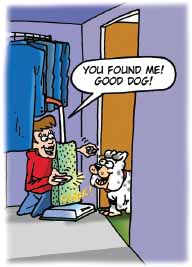
Never use the clicker itself to call your dog; it may confuse him into thinking the clicker is a cue for the
Next page
